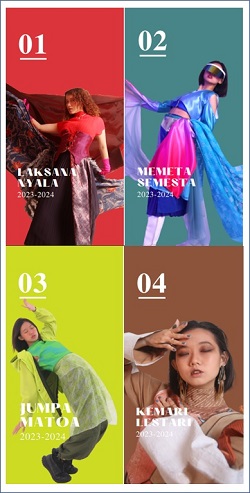Fabric exports (Harmonized System Code/HS Code 56 – 60) which are part of the Textile and Textile Products (TPT) industry cumulatively in January – March 2022 reached USD146.55 million or an increase of 14.63% compared to the period in the previous year /year on year (yoy). Meanwhile, the export volume of cloth was recorded at 30.93 thousand tons, or an increase of 7.57% yoy. The increase in cloth exports reached 83.93% during the first quarter of 2022, supported by total exports of Indonesian fabrics such as layered woven fabrics (HS Code 59) which increased by 43.19% yoy, followed by an increase in sales of cotton wadding and rope (HS Code 56) by 6 ,25% yoy, and knitted fabrics (HS Code 60) by 12.44% yoy.
"In general, the increase in fabric sales was driven by the recovery in demand for apparel, along with social activities returning to normal after the control of the spread of the Omicron variant. The use of e-commerce platforms in the midst of the pandemic has also become a positive catalyst because export sales of Indonesian fabrics are supported by a larger platform than before, so that it can increase the consumer base," said Head of Division of the Indonesia Eximbank Institute (IEB Institute), Indonesian Export Financing Agency (LPEI)/Indonesia Eximbank Rini Satriani, written Wednesday (15/6/2022).
Based on data processed by the IEB Institute, during the first quarter of 2022, the export value and growth of the five export destinations for Indonesian fabrics, namely to Japan, amounted to USD28.33 million or grew by 13.78% (YoY), Vietnam amounted to USD18.15 million, which grew by 13.78% (YoY). 11.50% (YoY), the United States at USD11.07 million or an increase of 11.91% (YoY) and India at USD10.25 million or an increase of 31.05% (YoY).
Meanwhile, for the same period, Indonesian cloth exports to South Korea decreased by 11.50% or reached USD 8.23 million.
The growth of cloth exports to the main destination countries has increased, with the exception of South Korea due to the high number of cases of Covid-19 infection during the first three months of this year.
"The high demand from Japan is in line with the seasonal effect in the form of the need for clothing production for spring and the easing of activity restrictions as of March 1, 2022. Furthermore, the increase in demand from Vietnam is not only due to controlling the spread of Covid-19 infection, but also due to a shift in orders from China to Vietnam as one of the fabric producing countries," explained Rini Satriani.
Separately, LPEI's Managing Director for Institutional Relations, Chesna F. Anwar added, LPEI has a SME Export Special Assignment program which is intended for export-oriented business actors to maintain business continuity.
"This program is part of the national economic recovery that the government has given us. We hope that the actors can use this program," he concluded.






